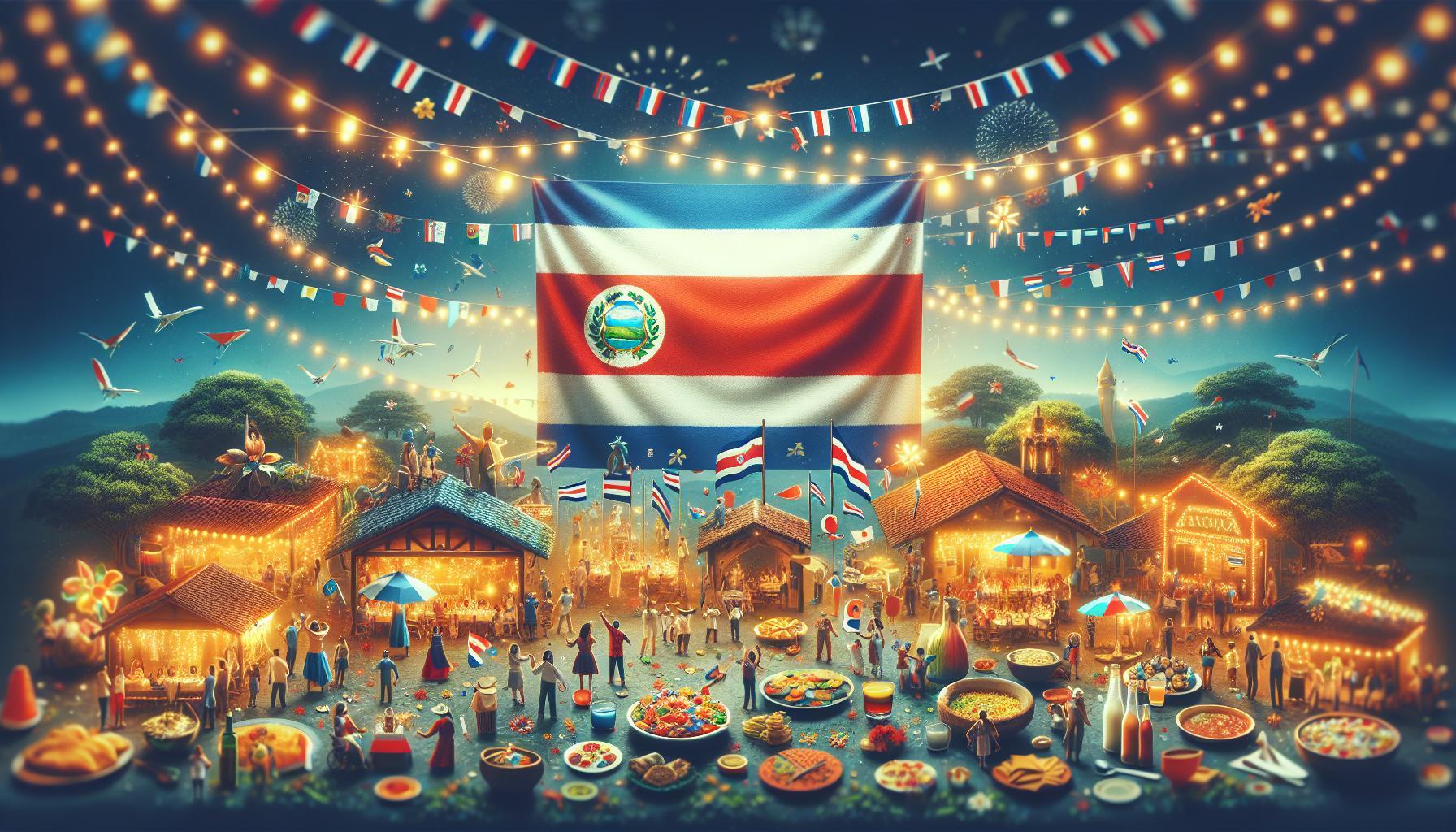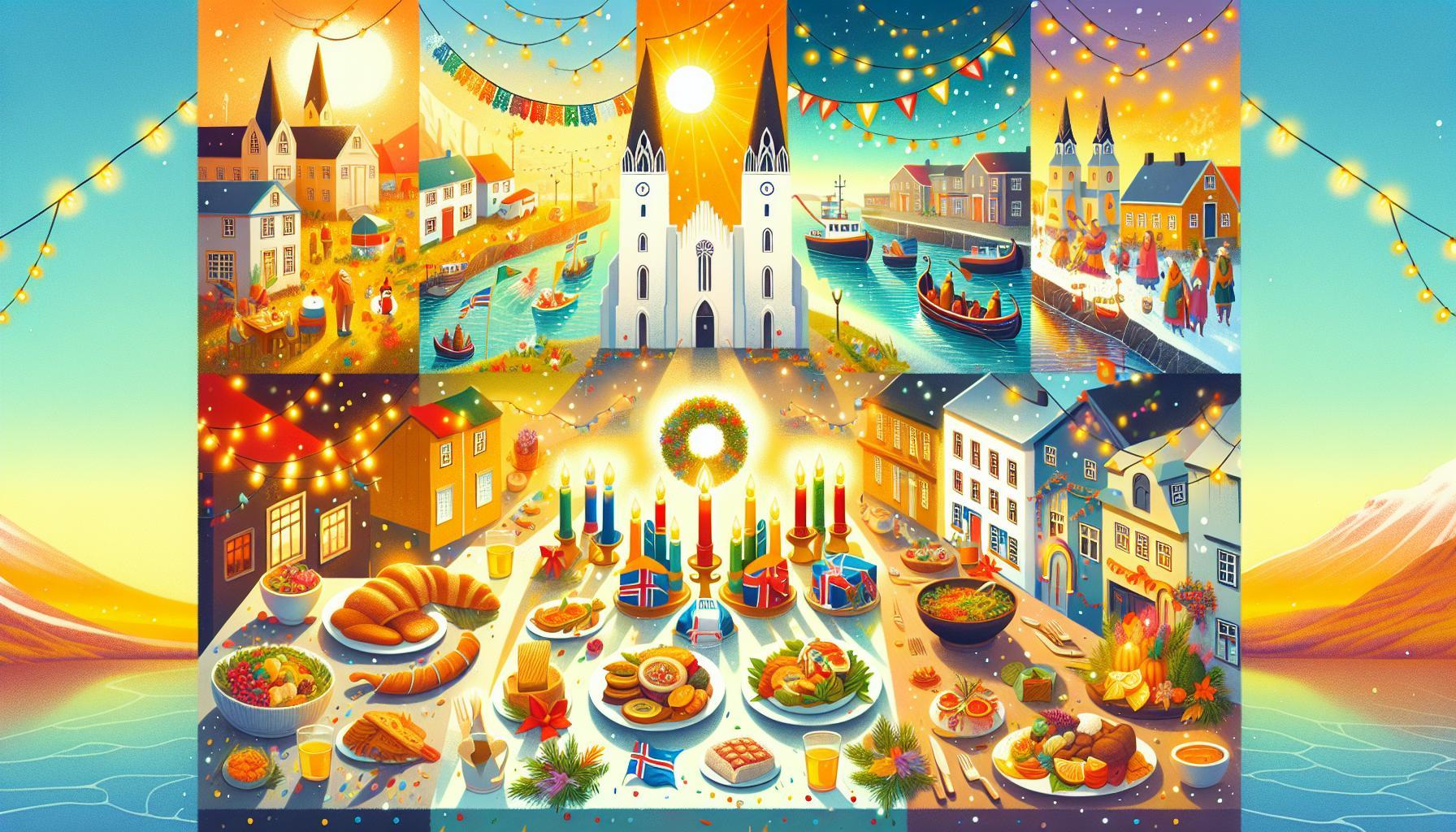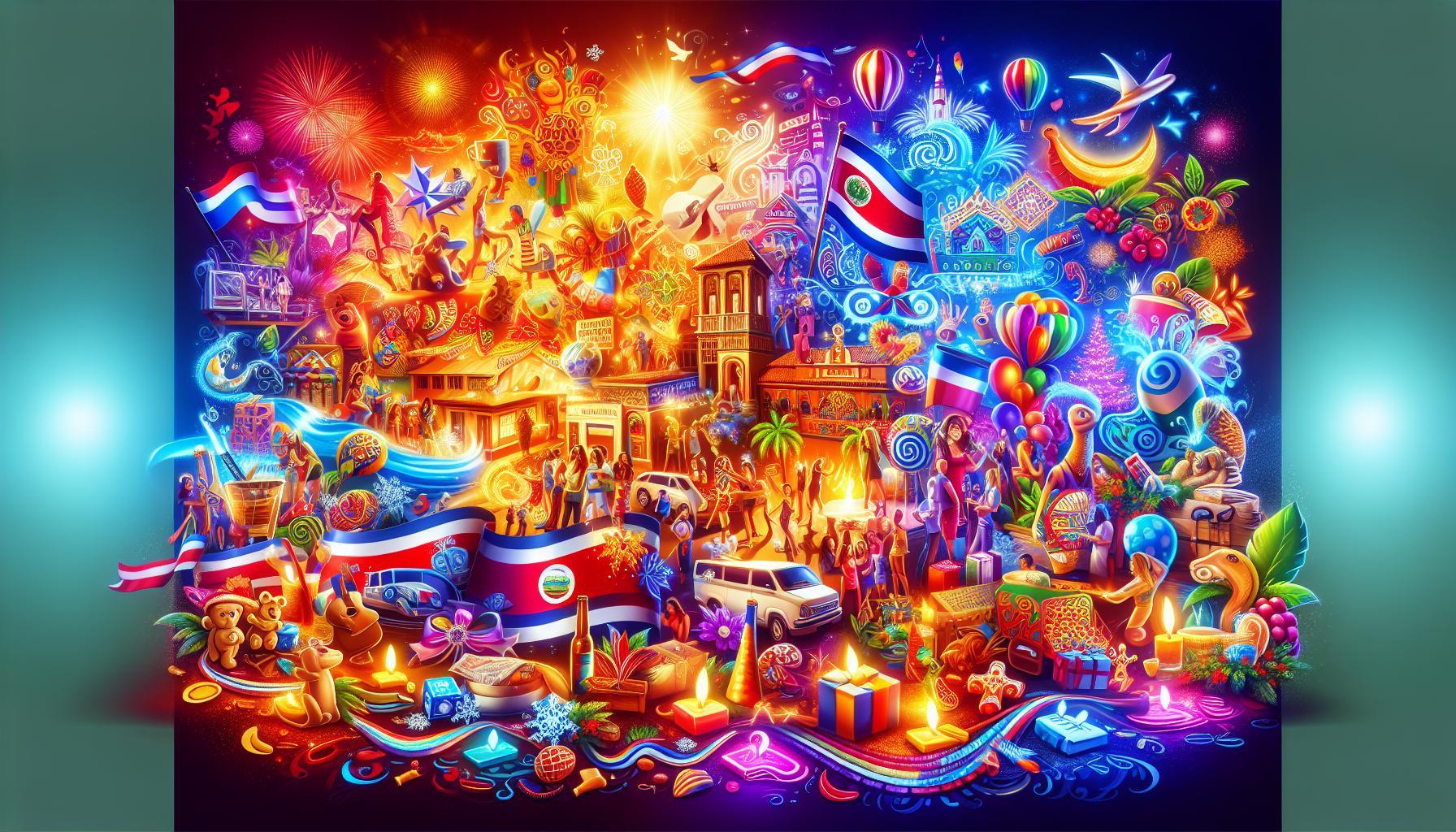The vibrant colors and intricate design of Costa Rica’s national emblem tell a profound story of its people and their values. Understanding the flag’s meaning and history unveils a narrative of sacrifice, hope, and a commitment to democracy, making it a vital aspect of Costa Rican identity and culture.
The Colors of Costa Rica: A Palette of Meaning and Unity
The vibrant colors of Costa Rica’s flag are more than just aesthetic choices; they are imbued with deep meaning and represent the nation’s collective identity and values. Each hue serves a purpose, weaving together the country’s ideals and aspirations into a cohesive narrative that reflects its history and the spirit of its people. Visitors to the country often find themselves enchanted not only by its natural beauty but also by the symbolism embodied in its flag.
The Significance of Blue, White, and Red
At first glance, the flag of Costa Rica features a striking tricolor design of blue, white, and red, with a central red stripe flanked by two white ones, all set against a blue background in the Republic’s national emblem. Each color contributes to a rich tapestry of meaning:
- Blue: Symbolizes the sky, opportunities, and perseverance. It embodies the dreams of the Costa Rican people for a bright future filled with potential.
- White: Represents peace, wisdom, and happiness, reflecting the country’s commitment to a harmonious society. It highlights Costa Rica’s long-standing identity as a beacon of stability in Central America.
- Red: Signifies the blood shed for freedom and the warmth of the Costa Rican people. It also represents a shared sense of patriotism and community that binds the nation together.
Unity in Diversity
Costa Rica’s flag is a unifying symbol that captures the essence of the nation. Amidst its diverse landscapes and cultures, its colors resonate with a message of solidarity among its citizens. The harmonious balance of colors captures the essence of Pura Vida, a phrase that translates to “pure life,” representing a collective philosophy of happiness and appreciation for life’s simple pleasures.
A Historical Tapestry
When exploring what the flag of Costa Rica entails in terms of meaning, history, and symbolism, it’s important to note that the flag underwent several changes before settling into its contemporary form in 1848. Each iteration echoed the national sentiments of the time, and the current configuration showcases not only the aesthetic preferences but also political ideals from Costa Rica’s history, including the republic’s emphasis on democracy and peace.
In understanding Costa Rica’s flag and its colors, one witnesses more than mere design; it represents a narrative of history, identity, and unity. This powerful visual symbol offers insights into the heart and soul of a nation that thrives on connection, resilience, and a shared vision for the future.
A Journey Through Time: The Historical Roots of Costa Rica’s Flag
From its striking blue, white, and red banners fluttering in the gentle Central American breeze, the flag of Costa Rica tells a compelling story steeped in history and symbolism. Understanding the roots of this emblem reveals much about the nation’s identity, values, and struggles throughout its journey to independence.
The flag’s design is an elegant reflection of Costa Rica’s vibrant history. The current flag was officially adopted in 1848; however, its elements can be traced back further to the early 19th century, when many Central American nations were influenced by the colors and symbolism of the French Revolution. The choices of blue, white, and red represent:
- Blue: the sky and opportunities for the future
- White: peace and wisdom
- Red: the blood shed for freedom and the warmth of the Costa Rican people
In time, the flag evolved to include a central coat of arms, distinguishing Costa Rica from other countries that share similar colors. This addition, representing the historical and geographical significance of the nation, was a significant step in establishing a unique Costa Rican identity within a regional context. The historical narrative is further enriched by notable events surrounding its adoption, such as the ongoing quest for democracy and the abolition of the army in 1949, which reflects the nation’s commitment to peace and resilience.
The evolution of the flag and its enduring symbolism serves as a reminder of Costa Rica’s journey through adversity toward a bright future. Each time the flag sways in the wind, it evokes pride among Costa Ricans and stands as a testament to their history—an inspiring illustration of how a simple piece of fabric can encapsulate a nation’s values and history in one powerful emblem.
From Local Legends to National Pride: Stories Behind the Flag
The flag of Costa Rica is more than just a piece of fabric; it’s a vibrant tapestry woven from the threads of history and cultural pride that unite the nation. Each element of the flag tells a story, echoing the legacy of local heroes and the diverse influences that shaped the Costa Rican identity. As citizens hold their flag high during national celebrations, they celebrate not only their country’s beauty but also the indomitable spirit that characterizes the Costa Rican people.
Symbolic Colors and Their Origins
The colors of the Costa Rican flag—blue, white, and red—are rich with symbolism and historical significance. The blue stripe at the top represents the sky, opportunities, and perseverance, while the white symbolizes peace, happiness, and goodwill. The central red stripe signifies the blood shed by Costa Rican heroes in their fight for freedom, serving as a poignant reminder of the sacrifices made for national sovereignty. This tripartite color scheme is reminiscent of the flags of other Central American nations but carries a distinctive narrative unique to Costa Rica.
The Birth of a National Identity
The evolution of the flag mirrors Costa Rica’s journey from a local legend to a symbol of national pride. Introduced in its current form in 1848, the flag was first hoisted during the formation of a new constitutional republic. The spirit of unity and resilience during this formative period is encapsulated in the flag’s design, reflecting the aspirations of early Costa Rican leaders who sought an identity separate from colonial powers.
Here are a few key figures whose stories knit into the fabric of this national emblem:
- José María de Castro: As the first Costa Rican president, he played a crucial role in the flag’s adoption, emphasizing a free and sovereign nation.
- Juanito Mora: Revered for his leadership in the 1856-1857 campaign against William Walker, his valor is remembered each time the flag is raised.
- La Bandera de Guerra: Originally a war flag, its use evolved to symbolize national pride and unity during times of peace.
Today’s Legacy and the Flag’s Role in Society
In contemporary Costa Rica, the flag transcends mere decoration; it serves as an emblem of collective identity and cultural heritage. Whether displayed in homes, schools, or during national festivities like Independence Day, it ignites a sense of belonging and pride among Costa Ricans.
Just as the flag’s meaning is cherished at the national level, it also resonates deeply within local communities, evolving local tales into national narratives. Schools often incorporate flag education into their curriculum, where children learn about historical figures alongside the symbolism of their flag. This way, history is continuously honored and passed down, ensuring that each generation recognizes the significance of their national colors and the stories they represent.
| Color | Symbolism |
|---|---|
| Blue | Sky, Opportunities, Perseverance |
| White | Peace, Happiness, Goodwill |
| Red | Blood of Heroes, Courage, Sacrifice |
The stories and symbols stitched into the Costa Rican flag remind us that we all contribute to a larger narrative, one that continues to evolve as each generation adds its own chapters to the rich history of this vibrant nation.
The Symbolism of the Costa Rican Flag: Exploring Its Elements
Costa Rica’s national flag is not just a piece of fabric; it is a vibrant emblem bursting with meaning that reflects the country’s rich history and values. With its unique design, the flag stands as a testament to the nation’s core principles and aspirations. At a glance, the blue, white, and red stripes tell a story that goes beyond mere colors. They are infused with symbolism and cultural significance, inviting exploration into what makes this flag an enduring beacon of Costa Rican identity.
The Color Palette and Its Significance
The flag consists of five horizontal stripes arranged in the following order:
- Blue: Represents the sky, opportunities, and perseverance.
- White: Symbolizes peace, happiness, and wisdom.
- Red: Denotes the blood shed for freedom and the warmth of Costa Rican hospitality.
Costa Rica’s flag beautifully incorporates the colors of blue, white, and red, influenced by the French flag as a nod to the ideals of liberty and equality. The blue stripes convey a sense of hope and optimism, reflecting the country’s aspiration to provide a better future for its citizens. The white symbolizes tranquility and peace, integral characteristics of the Costa Rican way of life. Ultimately, the red in the center serves as a powerful reminder of both the sacrifices made for independence and the warmth inherent in Costa Rican culture, creating a harmonious yet dynamic representation of national pride.
The Central Coat of Arms
While many might be familiar with the horizontal bands of color, the flag also features an emblem that enriches its symbolism. The Costa Rican coat of arms is typically displayed on the flag in the context of official use, showcasing three volcanoes and two oceans, surrounded by a vivid blue sky. This emblem embodies the unique geography and natural beauty of Costa Rica, tying together the physical landscape with elements of national identity.
| Element | Symbolism |
|---|---|
| Three Volcanoes | Represents the mountainous terrain and natural beauty. |
| Two Oceans | Symbolizes Costa Rica’s strategic position between the Atlantic and Pacific oceans. |
| The Sun | Reflects hope and prosperity for the nation. |
This intricate design highlights not only Costa Rica’s diverse geography but also its commitment to environmental conservation and appreciation of nature. By integrating these elements, the flag serves as both a national symbol and a reminder of the country’s ethos which prioritizes peace, sustainability, and harmony with the environment.
In sum, the analysis of Costa Rica’s flag reveals its multifaceted symbolism—every color and design choice contributes to the narrative of resilience, hope, and national pride. Delving into what truly constitutes the flag of Costa Rica: its meaning, history, and symbolism offers insights into the heart of a nation that cherishes peace above all.
How the Flag Reflects Costa Rica’s Values and Culture
The Costa Rican flag is more than just a simple piece of fabric; it serves as a vibrant symbol of the nation’s identity, history, and its citizens’ shared values. Designed with a unique array of colors and stripes, the flag not only represents the country but also embodies the principles that define Costa Rica as a nation: peace, democracy, and social justice. Each element of the flag is steeped in meaning, reflecting the culture that has flourished in this Central American gem.
Colors and Their Significance
At first glance, the Costa Rican flag features five horizontal stripes—two blue, two white, and a central red stripe that is more pronounced. Each color not only adds to the aesthetic appeal but is imbued with profound symbolism:
- Blue: Represents the sky, opportunities, and the idealistic spirit of its people.
- White: Symbolizes peace, happiness, and the country’s commitment to harmony.
- Red: Stands for blood shed in the struggle for freedom, as well as the warmth and generosity of the Costa Rican people.
This color scheme highlights the cultural importance of peace in Costa Rica, a nation famously known for abolishing its army in 1949 and prioritizing diplomatic resolutions over conflict. Such decisions resonate deeply within the cultural ethos, revealing a commitment to preserving peace and promoting social welfare.
A Reflection of Democratic Values
The flag also serves as a visual representation of democratic values throughout Costa Rica’s history. The country has a long-standing tradition of democratic governance, characterized by free elections and a strong civic engagement. The presence of white in the flag stands as a testament to these aspirations, emphasizing transparency, fairness, and equality within a democratic society.
The relationship between the flag’s elements and Costa Rica’s approach to governance can be witnessed in various national celebrations, including Independence Day, when citizens take to the streets proudly waving their flags. During these festivities, the flag serves not only as a cultural emblem but also as an invitation for unity and participation in democracy.
Social Justice and Environmental Commitment
As a nation recognized for its extensive conservation efforts, Costa Rica’s commitment to social justice is further represented through the symbol of the flag. The balance of colors echoes the country’s advancements in environmental policies, indicating a progressive approach to sustainability and ecological preservation. Costa Ricans take pride in their reputation as environmental stewards, and the flag stands as a representation of this collective responsibility.
In displaying the flag, citizens celebrate a culture rooted in advocacy for nature and human rights. The shared symbolism fosters a sense of community and encourages future generations to continue the legacy of nurturing the natural world while striving for equality and justice across social spectrums.
In essence, the Costa Rican flag encapsulates the spirit of the nation, portraying a rich tapestry of values centered around peace, democracy, and social justice. By understanding its significance, one gains deeper insight into what it means to be Costa Rican, reflecting a culture that cherishes freedom, unity, and the universal quest for a harmonious existence.
Celebrating Diversity: The Flag’s Role in National Identity
The vibrant flag of Costa Rica is not just a national emblem but also a profound symbol of the country’s identity and its commitment to diversity. The flag features five horizontal stripes, where the blue represents the sky, opportunities, and perseverance; the white symbolizes peace and happiness; and the red stands for the blood shed for freedom and the warmth of the Costa Rican people. These colors collectively embody the nation’s ethos, reflecting its multicultural identity and the harmony among its diverse populations.
Symbolism Embedded in the Flag
Each element of the flag is a reminder of Costa Rica’s values and its inclusivity. The horizontal stripes can also be interpreted as a metaphor for unity among the diverse groups that inhabit the country, transcending differences in ethnicity, culture, and tradition. This intentional design encourages citizens to embrace their unique backgrounds while fostering a shared national pride. In a world that often highlights divisions, the flag serves as a beacon of unity, emphasizing the importance of celebrating diversity in all its forms.
Practical Steps to Embrace Diversity through National Symbols
To deepen the appreciation of diversity and the flag’s role in national identity, individuals and communities can engage in activities such as:
- Educational Workshops: Organizing sessions that explore the flag’s history and what it represents can cultivate a greater understanding and respect for Costa Rica’s diverse populations.
- Cultural Celebrations: Hosting events that celebrate various cultural heritages, incorporating traditional music, cuisine, and art, can strengthen community bonds and promote inclusivity.
- Art Projects: Creating murals or art installations that incorporate the flag and its symbolism can enhance public spaces, reminding everyone of the importance of unity in diversity.
By emphasizing the role of the flag in illustrating national identity, Costa Ricans can reinforce their collective commitment to peace, mutual respect, and inclusivity. The flag thus becomes more than a mere symbol—it is a rallying point for all citizens to celebrate their individual and collective identities, embodying the essence of ‘What is the Flag of Costa Rica: Meaning, History & Symbolism.’
Flag Unfurled: When and How Costa Ricans Display Their Colors
Costa Rica’s flag is not just a beautifully crafted emblem; it’s a vibrant testament to the nation’s pride, history, and identity. Displaying the flag is a meaningful tradition, deeply embedded in the culture, particularly during significant national events and holidays. Understanding how and when Costa Ricans proudly showcase their colors can illuminate the importance of this flag in daily life and special occasions.
Key Occasions for Displaying the Flag
Costa Ricans display their flag during a variety of important national events throughout the year. The most notable among these occasions includes:
- Independence Day (September 15): Celebrating freedom from Spanish rule, communities across the country come alive with parades, including vibrant displays of the flag.
- International Workers’ Day (May 1): Many Costa Ricans march to honor labor rights and showcase their national pride with the flag prominently displayed.
- National Symbols Day (March 19): On this day dedicated to national symbols, the flag becomes a focus of respect and admiration.
Everyday Life and Personal Displays
Apart from these national celebrations, flags can often be seen in everyday settings. In residential areas, many Costa Ricans choose to display the flag at their homes, especially during important national holidays. It not only beautifies the environment but also serves as an expression of patriotism. Schools, government offices, and public buildings predominantly feature the flag, reinforcing its imagery as a symbol of unity and pride.
The Proper Etiquette for Displaying the Flag
To ensure respectful display of the flag, Costa Ricans follow certain guidelines, which reflect their deep reverence for this national symbol. Key practices include:
- Displaying the flag on a flagpole, preferably in an elevated position.
- Ensuring the flag is clean and in good condition; a worn or tattered flag is usually replaced.
- Following proper flag etiquette during ceremonies and public gatherings, where the national anthem is often played as a tribute.
By understanding the significance behind when and how Costa Ricans display their flag, one can appreciate the rich tapestry of meaning woven into each color and stripe. Every flag unfurling is not just a local gesture but a vibrant expression of a nation’s history, aspiration, and the enduring spirit of its people.
Understanding the Legal Aspects: Flag Etiquette in Costa Rica
Costa Rica’s flag is not just a vibrant symbol of national pride but also comes with a set of legal guidelines that govern its display. Understanding the legal aspects of flag etiquette in this Central American country helps ensure that citizens and visitors alike respect its rich history and cultural significance. Established by law, these rules serve as a societal reflection of honor and respect for the nation and its values.
Legal Framework Governing Flag Etiquette
The use of the Costa Rican flag is regulated under various laws that underscore its importance in national identity. According to the General Law of the Costa Rican Flag and Anthem, specific guidelines dictate how the flag should be displayed, treated, and honored. Here are some key points covered by this law:
- Respect and Dignity: The flag must always be treated with the utmost respect. It should never touch the ground or be used for commercial purposes.
- Proper Display: When displayed with other flags, the Costa Rican flag should be positioned in a place of honor, either to the right or at a higher level than others.
- Special Occasions: The flag is prominently displayed during national holidays and celebrations, particularly on September 15, which marks Costa Rica’s Independence Day.
Common Etiquette Practices
In addition to legal requirements, various cultural practices align with proper flag etiquette. These practices not only reinforce the legal guidelines but also encourage citizens to embrace their national identity. Following are some common etiquette practices related to the flag:
- Raising and Lowering: The flag should be raised at sunrise and lowered at sunset, often accompanied by the national anthem.
- Worn Flags: If a flag becomes tattered or worn, it should be properly disposed of, preferably through a ceremonial retirement.
- Educational Importance: Schools often teach children about the significance of the flag, promoting a deep-rooted respect that transcends generations.
Penalties for Disrespect
While educational outreach is emphasized, the law also outlines repercussions for disrespecting the flag. Violations can lead to administrative sanctions or fines, serving as a deterrent against ill treatment. This rigid approach to flag etiquette ensures a collective commitment to upholding national pride.
By understanding these legal aspects and etiquette practices surrounding the flag of Costa Rica, one can foster a deeper appreciation for its meaning, history, and symbolism. Whether you are a resident or a visitor, adhering to these guidelines will not only show respect but also enrich your experience in this beautiful nation.
Connecting with Costa Rica: Personal Reflections on the Flag’s Impact
The colors and symbols of national flags often evoke strong feelings of pride and identity among citizens, and the Costa Rican flag is no exception. Each element carries deep meaning, weaving a narrative of history, culture, and aspirations that resonate with those who call this Central American gem home. As we explore the significance of the Costa Rican flag, its impact goes beyond mere fabric; it connects people to their heritage and inspires a sense of unity and purpose.
The Costa Rican flag features five horizontal stripes: a blue stripe at the top and bottom, followed by a white stripe, a thick red stripe in the center, and a coat of arms on the white stripe for the nation’s official flag. The interplay of colors is rich in meaning:
Symbolism of the Colors
- Blue: Represents the sky and opportunities that lie ahead.
- White: Symbolizes peace, happiness, and serenity, reflecting the country’s commitment to harmony.
- Red: Signifies the blood shed for liberty and the warmth of the Costa Rican people.
These colors—rooted in ideals of democracy and social justice—foster a coherent national identity among Costa Ricans. Additionally, the coat of arms includes three volcanoes, symbolizing the geographical majesty of the country, as well as a valley and a rising sun, indicating hope for a bright future. The coat of arms is not just a decorative addition; it reminds citizens of their land’s rich natural beauty and cultural heritage.
Beyond symbolism, the flag acts as a beacon during national celebrations and events. For instance, during the Independence Day festivities in September, the flag’s prominence unites citizens in celebrations of their freedom and history. It serves not only as a backdrop but as a vital part of the ceremonies, as families proudly display their flags from homes and schools, reinforcing a sense of belonging and shared history. The iconic design of the flag has become a source of inspiration, with many local artists incorporating its elements into their work, illustrating how the flag encourages pride, national unity, and creativity among generations.
In summary, the flag of Costa Rica is much more than a national symbol; it embodies the spirit of a nation, intertwining individual and collective identities. Understanding what lies behind the design enhances a connection to this vibrant culture and guides further exploration into what makes Costa Rica truly unique.
Frequently asked questions
What is the Flag of Costa Rica: Meaning, History & Symbolism?
The Flag of Costa Rica consists of five horizontal stripes and represents peace, liberty, and patriotism. The three blue stripes symbolize the sky, opportunities, and perseverance. The white stands for peace and happiness, while the red, larger central stripe, signifies the bloodshed for freedom.
Costa Rica’s flag has a rich history that dates back to 1848, inspired by the flags of France and the Netherlands. Its unique design reflects the nation’s commitment to progress, democracy, and social justice. The flag is flown proudly during national celebrations, fostering a sense of unity and national pride.
Why does the Flag of Costa Rica have a unique design?
The unique design of the Flag of Costa Rica represents its historical context and values. The three blue stripes stand for the sky and opportunities, while the white symbolizes peace. The larger red stripe expresses the willingness to fight for liberty and emphasizes a commitment to social progress.
This flag was officially adopted in 1848, and its design intentionally diverged from the usual layout to showcase Costa Rican identity. It reflects the nation’s emphasis on democracy and is an emblem of Costa Rican pride displayed during festivities and important national events.
Can I visit places in Costa Rica that feature the flag’s symbolism?
Yes, many locations in Costa Rica honor the flag and its symbolism. For instance, you can visit historical sites like the National Museum of Costa Rica, where the culture and flag’s meaning come alive through exhibits, or even participate in local festivals celebrating national pride.
Additionally, exploring the various towns during festivities can provide insight into the flag’s significance. Observing how locals display the flag throughout their communities adds a personal touch to your experience, making it even more memorable.
What do the colors of the Flag of Costa Rica represent?
The colors of the Flag of Costa Rica carry deep meanings. The blue stripes represent the sky, opportunities, and hope, while the white symbolizes peace and happiness. The red stripe, which is the widest, signifies the blood of Costa Ricans who fought for freedom.
This color scheme highlights the values that Costa Ricans hold dear, fostering a national identity and pride that resonates throughout the country. Each color contributes to the flag’s status as a symbol of liberty, peace, and progress.
How has the Flag of Costa Rica evolved over time?
The Flag of Costa Rica has undergone minimal changes since its adoption in 1848. Initially, variations existed, but the official design has remained consistent, signifying stability and national pride. The flag’s evolution mirrors the growth of the nation itself.
Over time, the flag has become an emblem of democracy and peace, reflecting the country’s dedication to a lifestyle without a standing army and prioritizing education and social welfare. This enduring design resonates deeply with Costa Ricans today and is celebrated nationwide.
Why is the Flag of Costa Rica important to its citizens?
The Flag of Costa Rica holds great significance to its citizens as a representation of their history, values, and identity. It embodies the sacrifices made for freedom and continues to inspire pride and unity among the people.
During national holidays, such as Independence Day on September 15, the flag is prominently displayed, encouraging citizens to reflect on their country’s heritage and commitment to peace. Such occasions reinforce the cultural significance of the flag within the national consciousness.
What events feature the Flag of Costa Rica prominently?
Important events, such as Costa Rica’s Independence Day on September 15, prominently feature the Flag of Costa Rica. This day commemorates freedom from Spanish rule, and the flag becomes a central symbol during parades and celebrations across the country.
School children often participate in marches carrying flags, which strengthens the sense of national identity. Other local festivals throughout the year also highlight the flag, incorporating its colors into decorations and clothing, further cultivating a shared cultural experience.
Wrapping Up
As we conclude our exploration of the Costa Rican flag, it becomes clear that this vibrant emblem is more than just a piece of cloth; it tells a story steeped in history and culture. The alternating stripes of blue, white, and red symbolize the sky, peace, and generosity, respectively, reflecting the spirit of the nation. The striking red stripe, which is twice the width of the others, represents the blood shed for freedom, and the addition of the coat of arms in government flags signifies national pride.
Venturing into the heart of Costa Rica, you can witness this flag waving proudly at civic events, with locals sharing stories of their heritage intertwined with the flag’s significance. Imagine participating in a festival in a bustling plaza, where families come together to celebrate their identity, and the flags flutter in the warm breeze, a reminder of unity and hope.
So, whether you are planning a visit to Costa Rica, considering a longer stay, or simply looking to learn more about its rich tapestry of culture, let the flag be your gateway. Dive deeper into the stories it represents, connect with local traditions, and let your curiosity guide you as you journey through this beautiful country. Embrace the adventure, and who knows? You might find a piece of Costa Rica that resonates with your heart. Safe travels!






